市场营销 英文版
科特勒市场营销讲义英文版课件

Data Driven Decision Making: The availability of big data has enabled businesses to make data driven decisions in marketing By analyzing customer data, businesses can understand consumer preferences and behaviors and customize their offers accordingly
Competitiveness
Marketing helps businesses differentiate their products and services from those of their competitors It enables them to establish a unique position in the market and attract customers
Innovators
These consumers are early adopters of new products and services and are attracted to novelty and uniqueness They are often open to trying new brands or products and are willing to pay higher prices for the latest trends
Consumer decision making process
Evaluation of alternatives
Once information is gathered, consumers evaluate different product or service options to determine which one best suits their needs and budget Consumers consider factors like price, quality, functionality, and brand reporting
市场营销学英文版第13版

市场营销学英文版第13版Here is an English essay on the topic "Marketing, 13th Edition":Marketing is a multifaceted discipline that encompasses a wide range of strategies and techniques aimed at understanding consumer behavior, creating and delivering value, and ultimately driving business success. The 13th edition of the renowned Marketing textbook delves deep into the evolving landscape of marketing, equipping students and professionals with the knowledge and tools necessary to navigate the increasingly complex and dynamic market environment.At its core, marketing is about identifying and satisfying customer needs and wants. The 13th edition of the Marketing textbook provides a comprehensive overview of the fundamental principles and practices that underpin effective marketing strategies. It explores the process of market segmentation, target market selection, and positioning, empowering readers to develop tailored approaches that resonate with their target audience.One of the key aspects highlighted in this edition is the importance of understanding consumer behavior. The textbook delves into thepsychological, social, and cultural factors that influence consumer decision-making, enabling marketers to craft more personalized and compelling value propositions. By delving into consumer insights, the 13th edition equips readers with the ability to anticipate and respond to evolving consumer needs and preferences.Another crucial component covered in the 13th edition is the integration of digital technologies in marketing. In an increasingly connected world, the textbook examines the impact of digital channels, social media, and e-commerce on marketing strategies. It provides valuable insights into leveraging these digital tools to enhance customer engagement, improve brand visibility, and drive sales.The 13th edition also places a strong emphasis on the role of strategic marketing planning. It guides readers through the process of developing comprehensive marketing plans that align with an organization's overall business objectives. From conducting market analysis to formulating marketing mix decisions, the textbook equips readers with the skills needed to make data-driven, strategic marketing decisions.Furthermore, the 13th edition delves into the importance of ethical and socially responsible marketing practices. It explores the growing expectations of consumers and stakeholders for organizations toadopt sustainable and socially conscious approaches. By addressing these crucial considerations, the textbook prepares readers to navigate the complexities of the modern marketing landscape and contribute to the development of more responsible and impactful marketing strategies.Throughout the textbook, the 13th edition of Marketing seamlessly integrates case studies, industry examples, and real-world applications to bridge the gap between theory and practice. This approach allows readers to explore the practical implications of marketing concepts and apply their learnings to real-world scenarios.In conclusion, the 13th edition of the Marketing textbook is a comprehensive and invaluable resource for students, educators, and marketing professionals alike. It provides a robust foundation in the fundamental principles of marketing, while also addressing the evolving trends and emerging challenges in the field. By equipping readers with the knowledge and skills necessary to navigate the dynamic marketing landscape, this edition of the textbook empowers individuals to become strategic and adaptable marketing professionals, poised to drive success in the ever-changing business environment.。
Marketing市场营销(英文版)
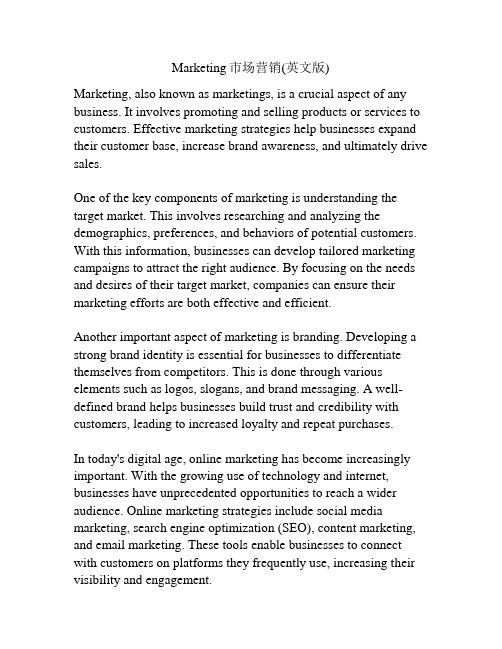
Marketing市场营销(英文版)Marketing, also known as marketings, is a crucial aspect of any business. It involves promoting and selling products or services to customers. Effective marketing strategies help businesses expand their customer base, increase brand awareness, and ultimately drive sales.One of the key components of marketing is understanding the target market. This involves researching and analyzing the demographics, preferences, and behaviors of potential customers. With this information, businesses can develop tailored marketing campaigns to attract the right audience. By focusing on the needs and desires of their target market, companies can ensure their marketing efforts are both effective and efficient.Another important aspect of marketing is branding. Developing a strong brand identity is essential for businesses to differentiate themselves from competitors. This is done through various elements such as logos, slogans, and brand messaging. A well-defined brand helps businesses build trust and credibility with customers, leading to increased loyalty and repeat purchases.In today's digital age, online marketing has become increasingly important. With the growing use of technology and internet, businesses have unprecedented opportunities to reach a wider audience. Online marketing strategies include social media marketing, search engine optimization (SEO), content marketing, and email marketing. These tools enable businesses to connect with customers on platforms they frequently use, increasing their visibility and engagement.Another effective marketing technique is influencer marketing.This involves collaborating with influential individuals, such as celebrities or social media personalities, to promote products or services. By leveraging the popularity and credibility of these influencers, businesses can reach a larger audience and gain credibility and trust from their followers.Marketing also involves analyzing and measuring the effectiveness of marketing campaigns. This is done through metrics such as return on investment (ROI), customer acquisition cost (CAC), and customer lifetime value (CLTV). By tracking these metrics, businesses can evaluate the success of their marketing efforts and make any necessary adjustments to optimize their strategies.In conclusion, marketing plays a vital role in business success. It helps businesses understand their target market, build strong brands, and reach a wider audience through various channels. By implementing effective marketing strategies, businesses can increase their customer base, boost brand awareness, and ultimately drive sales.在一个竞争激烈的商业环境中,有效的营销策略是企业取得成功的关键。
市场营销(英文版)
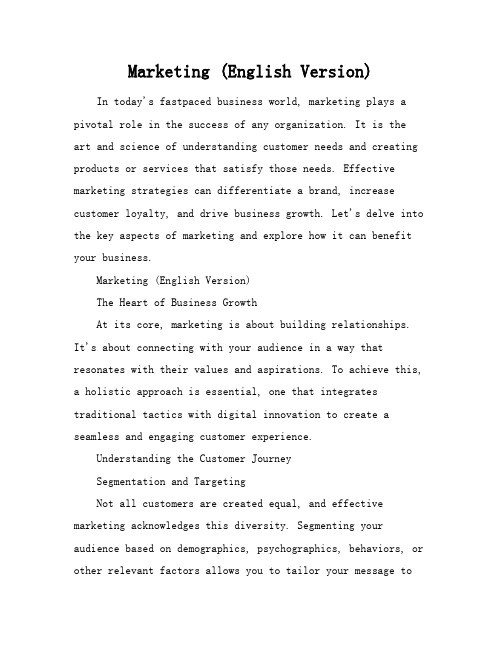
Marketing (English Version) In today's fastpaced business world, marketing plays a pivotal role in the success of any organization. It is theart and science of understanding customer needs and creating products or services that satisfy those needs. Effective marketing strategies can differentiate a brand, increase customer loyalty, and drive business growth. Let's delve into the key aspects of marketing and explore how it can benefit your business.Marketing (English Version)The Heart of Business GrowthAt its core, marketing is about building relationships.It's about connecting with your audience in a way that resonates with their values and aspirations. To achieve this, a holistic approach is essential, one that integrates traditional tactics with digital innovation to create a seamless and engaging customer experience.Understanding the Customer JourneySegmentation and TargetingNot all customers are created equal, and effective marketing acknowledges this diversity. Segmenting your audience based on demographics, psychographics, behaviors, or other relevant factors allows you to tailor your message todifferent groups. This targeted approach ensures that your marketing efforts are more relevant and, consequently, more effective.The Power of StorytellingStories are a universal language that can evoke emotions and create lasting memories. In marketing, storytelling is a powerful tool that can humanize your brand and make it more relatable. By crafting narratives that align with yourbrand's values and mission, you can forge a deeper connection with your audience and inspire them to take action.Leveraging Digital ChannelsMeasuring SuccessMarketing is an investment, and like any investment, it needs to be measured for return. Key performance indicators (KPIs) such as conversion rates, customer acquisition costs, and customer lifetime value provide a clear picture of your marketing efforts' effectiveness. By analyzing these metrics, you can refine your strategies, optimize your budget, and ensure that your marketing activities contribute to your business's bottom line.Continuous ImprovementMarketing (English Version)The Art of Persuasion and EngagementThe essence of marketing lies in its ability to persuade and engage. It's not just about selling products; it's about selling an experience, a lifestyle, and a vision. Here's how businesses can harness the full potential of marketing to achieve their goals.Crafting a Compelling Brand IdentityInfluencing Consumer BehaviorUnderstanding the psychology behind consumer behavior is crucial for marketers. By identifying the triggers that lead to purchasing decisions, you can design campaigns that nudge potential customers towards conversion. This involves not only the rational aspects of product features and benefits but also the emotional appeal that can often be the deciding factor in a consumer's choice.The Role of Content MarketingContent marketing is the strategic creation and distribution of valuable, relevant, and consistent content to attract and retain a clearly defined audience. It's about educating your customers, entertaining them, and providing solutions to their problems. From blog posts to videos, infographics to podcasts, highquality content can establish your brand as an authority in your industry and build trust with your audience.Collaborating with InfluencersCustomer Engagement and Retention Ethical Marketing Practices。
市场营销策划方案英文版
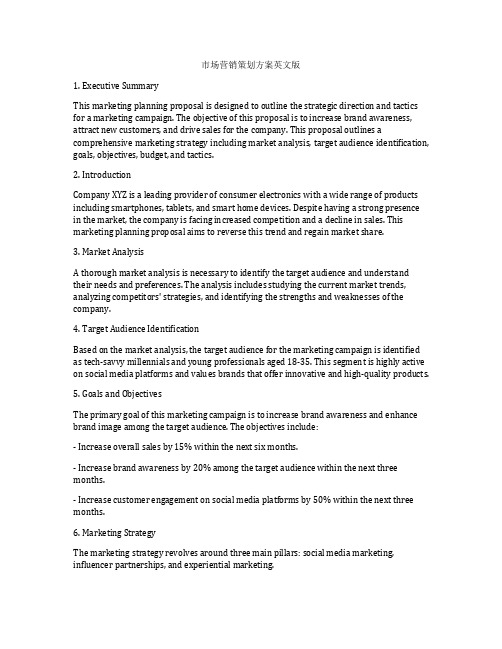
市场营销策划方案英文版1. Executive SummaryThis marketing planning proposal is designed to outline the strategic direction and tactics for a marketing campaign. The objective of this proposal is to increase brand awareness, attract new customers, and drive sales for the company. This proposal outlines a comprehensive marketing strategy including market analysis, target audience identification, goals, objectives, budget, and tactics.2. IntroductionCompany XYZ is a leading provider of consumer electronics with a wide range of products including smartphones, tablets, and smart home devices. Despite having a strong presence in the market, the company is facing increased competition and a decline in sales. This marketing planning proposal aims to reverse this trend and regain market share.3. Market AnalysisA thorough market analysis is necessary to identify the target audience and understand their needs and preferences. The analysis includes studying the current market trends, analyzing competitors' strategies, and identifying the strengths and weaknesses of the company.4. Target Audience IdentificationBased on the market analysis, the target audience for the marketing campaign is identified as tech-savvy millennials and young professionals aged 18-35. This segment is highly active on social media platforms and values brands that offer innovative and high-quality products.5. Goals and ObjectivesThe primary goal of this marketing campaign is to increase brand awareness and enhance brand image among the target audience. The objectives include:- Increase overall sales by 15% within the next six months.- Increase brand awareness by 20% among the target audience within the next three months.- Increase customer engagement on social media platforms by 50% within the next three months.6. Marketing StrategyThe marketing strategy revolves around three main pillars: social media marketing, influencer partnerships, and experiential marketing.6.1 Social Media MarketingA comprehensive social media marketing plan will be executed to reach and engage with the target audience. This includes creating and optimizing social media profiles, developing a content calendar with relevant and engaging posts, and running targeted advertising campaigns.6.2 Influencer PartnershipsPartnering with influencers is an effective way to reach the target audience and gain credibility. Key opinion leaders in the consumer electronics industry will be identified and engaged to promote the company's products through sponsored content and product reviews.6.3 Experiential MarketingCreating immersive experiences for potential customers is crucial in showcasing the products' features and benefits. This can be achieved through pop-up stores, product launch events, and interactive demonstrations in high-traffic areas.7. Budget AllocationA detailed budget allocation plan is essential to ensure efficient spending of marketing resources. The budget will be divided as follows:- Social media marketing: 40%- Influencer partnerships: 25%- Experiential marketing: 20%- Miscellaneous expenses: 15%8. Measurement and EvaluationTo monitor the effectiveness of the marketing campaign, key performance indicators (KPIs) will be established. These include but are not limited to sales growth, website traffic, social media engagement, and customer feedback. Regular monitoring and analysis of these KPIs will guide future marketing decisions and help evaluate the campaign's success.9. ConclusionThis marketing planning proposal provides a comprehensive strategy for XYZ Company to improve brand awareness, attract new customers, and drive sales. By leveraging social media marketing, influencer partnerships, and experiential marketing, the company can successfully engage with the target audience and achieve its goals and objectives. With proper monitoring and evaluation, adjustments can be made to optimize the campaign and ensure long-term success.。
【市场营销英文版】08Market Segmentation and Targeting1

Market Segmentation
Markets can be huge and diverse entities made up of individuals. Since individual wants and needs tend to differ, trying to mass market to a whole market often is inefficient. Costing too much time and money, and hurting profit potential. Therefore, a company should focus or target specific groups or segments of individuals to enhance profit opportunities.
Market Targeting
Types of Targeting Decisions: • Single-segment concentration • Selective specialization • Product specialization • Market specialization • Full market coverage
Market Segmentation
Some will argue that mass marketing is better, because lower overall production costs are achieved. Lower expenses then leads to higher profits.
However, unless almost everyone is buying your product/service, the lower expenses will not necessary mean higher profits.
市场营销专业术语中英文对照标准翻译
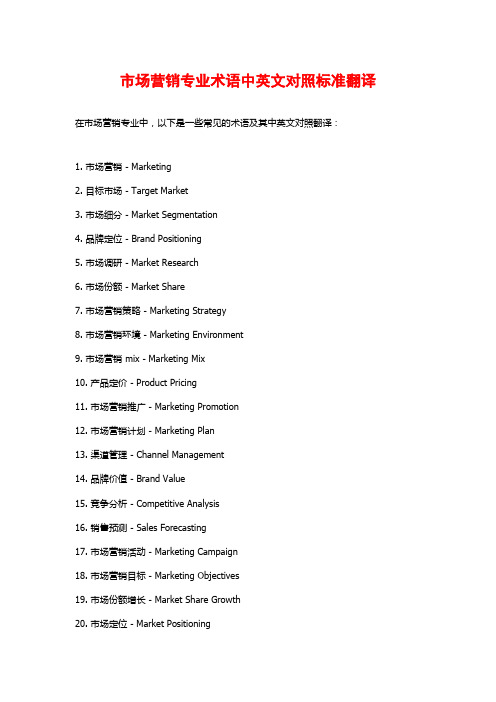
市场营销专业术语中英文对照标准翻译在市场营销专业中,以下是一些常见的术语及其中英文对照翻译:
1. 市场营销 - Marketing
2. 目标市场 - Target Market
3. 市场细分 - Market Segmentation
4. 品牌定位 - Brand Positioning
5. 市场调研 - Market Research
6. 市场份额 - Market Share
7. 市场营销策略 - Marketing Strategy
8. 市场营销环境 - Marketing Environment
9. 市场营销 mix - Marketing Mix
10. 产品定价 - Product Pricing
11. 市场营销推广 - Marketing Promotion
12. 市场营销计划 - Marketing Plan
13. 渠道管理 - Channel Management
14. 品牌价值 - Brand Value
15. 竞争分析 - Competitive Analysis
16. 销售预测 - Sales Forecasting
17. 市场营销活动 - Marketing Campaign
18. 市场营销目标 - Marketing Objectives
19. 市场份额增长 - Market Share Growth
20. 市场定位 - Market Positioning
这些术语可以帮助您理解和沟通市场营销的概念和策略。
请注意,有时候术语的翻译可能存在一定的灵活性,具体使用时需要结合实际情境和语境进行理解。
市场营销专业英文介绍

市场营销专业英文介绍如下:Marketing is a major that explores the theories, concepts, and practices related to the promotion and sale of goods and services. It combines elements of psychology, sociology, and business to understand consumer behavior and market trends.The main focus of the marketing major is to provide students with a deep understanding of marketing concepts, strategies, and techniques. This includes an examination of buyer behavior, market research, product development, pricing, promotion, distribution, and sales.Students in this major also learn about marketing ethics and sustainability, as well as how to use digital tools and technologies to enhance marketing efforts. Additionally, they gain hands-on experience through internships, case studies, and other practical projects.The knowledge and skills gained through a marketing major can be applied in various industries, such as consumer goods, healthcare, technology, and non-profit organizations. Students who pursue this major often go on to become marketing managers, brand managers, product managers, or consultants in the private or public sector.总体来说,市场营销专业是一个综合性的学科,旨在培养学生在市场营销领域的理论知识和实践技能。
市场营销英文版科特勒PPT课件

Copyright © 2012 Pearson Education, Inc. Publishing as Prentice Hall
Chapter 4- slide 7
Assessing Marketing Information Needs
Characteristics of a Good MIS
Copyright © 2012 Pearson Education, Inc. Publishing as Prentice Hall
Chapter 4- slide 13
Consider a local business near campus. . .
How would they conduct exploratory research?
WhatDmeigvhtetlhoeypwinangt tMo fiandrkoeuttiinndgesIcnripftoivremresaetairochn?
What relationships might they explore in causal research?
Marketing Research Defining the Problem and Research Objectives
Internal Data
Internal databases are electronic collections of consumer and market information obtained from data sources within the company network
• Cookies
Copyright © 2012 Pearson Education, Inc. Publishing as Prentice Hall
市场营销英语单词完整版
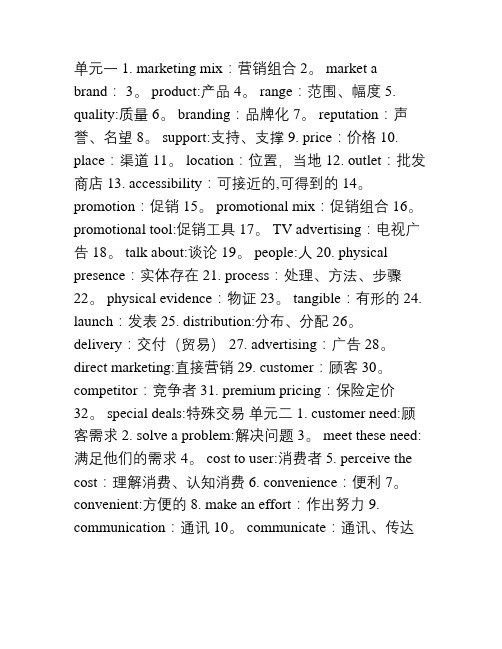
单元一 1. marketing mix:营销组合 2。
market a brand: 3。
product:产品 4。
range:范围、幅度 5. quality:质量 6。
branding:品牌化 7。
reputation:声誉、名望 8。
support:支持、支撑 9. price:价格 10. place:渠道 11。
location:位置,当地 12. outlet:批发商店 13. accessibility:可接近的,可得到的 14。
promotion:促销 15。
promotional mix:促销组合 16。
promotional tool:促销工具 17。
TV advertising:电视广告 18。
talk about:谈论 19。
people:人 20. physical presence:实体存在 21. process:处理、方法、步骤22。
physical evidence:物证 23。
tangible:有形的 24. launch:发表 25. distribution:分布、分配 26。
delivery:交付(贸易) 27. advertising:广告 28。
direct marketing:直接营销 29. customer:顾客 30。
competitor:竞争者 31. premium pricing:保险定价32。
special deals:特殊交易单元二 1. customer need:顾客需求 2. solve a problem:解决问题 3。
meet these need:满足他们的需求 4。
cost to user:消费者 5. perceive the cost:理解消费、认知消费 6. convenience:便利 7。
convenient:方便的 8. make an effort:作出努力 9. communication:通讯 10。
市场营销(英文版)

Total customer value
product value, service value, personal value, image value
Total customer cost
Price, time, energy,
CDV=TCV-TCC
The aim of Marketing is to make selling superfluous. The aim is to know and understand the customer so well that the product or services fits… and sells itself. (Drucker, 1973)
The function of marketing is to identify changing needs so that innovative products can be developed to meet them better than competitors.
Marketing is…
l
Journals:
Journal of Marketing
Marketing News
Harvard Business Review
International Journal of Research in Marketing
Journal of Advertising 《营销导刊》 《销售与市场》 《市场营销》(人大复印资料)
Number ability willing
present market / potential market
M=N+W +A
Marketing市场营销(英文版)

Marketing市场营销(英文版)Marketing is a critical aspect of any business. It involves promoting and selling products or services to customers through various strategies and channels. In today's competitive market, effective marketing techniques are essential to differentiate a company from its competitors and maximize its potential for success.One of the primary goals of marketing is to understand customer needs and wants. By conducting market research and gathering data, companies can identify their target audience and tailor their marketing efforts accordingly. This customer-centric approach allows businesses to create products or services that meet customer demands and exceed their expectations.Marketing involves developing an effective marketing mix, which includes the product, price, promotion, and place. The product refers to the goods or services being offered and must meet customer needs and preferences. Setting the right price is crucial to ensure the product's affordability and value. Promotion involves the various strategies used to communicate with potential customers and create awareness about the product or service. Lastly, ensuring the product is available at the right place and time is essential to enable customers to access and purchase it conveniently.Digital marketing has become an integral part of successful marketing campaigns. With the widespread use of the internet and social media, companies need to embrace online marketing techniques to reach a broader audience. Digital marketingstrategies include search engine optimization (SEO), content marketing, social media advertising, email marketing, and influencer marketing. These methods help businesses connect with potential customers, increase brand visibility, and generate leads.Another critical aspect of marketing is building and maintaining strong customer relationships. Customer relationship management (CRM) is a strategy that helps companies track and analyze customer interactions to improve their overall experience. By understanding customer preferences, addressing their concerns, and providing excellent customer service, companies can build loyalty and retain customers in the long run.In today's fast-paced and highly competitive market, companies need to stay ahead of their competitors by continuously enhancing their marketing strategies. This requires staying updated with the latest marketing trends and technologies, monitoring competitor activities, and adapting accordingly. Additionally, companies must be flexible and willing to adjust their marketing efforts as market conditions and customer preferences change.In conclusion, marketing plays a vital role in the success of any business. By understanding customer needs, developing an effective marketing mix, embracing digital marketing techniques, and building strong customer relationships, companies can maximize their potential and stay ahead of the competition. It is crucial for businesses to continuously improve their marketing strategies to remain relevant and meet the evolving demands of their target audience.继续发展相关主题-内容营销:内容营销是当下营销领域的一个重要策略。
【商务英语】市场营销(中英)

1.Marketing 市场营销:通过方案和执行关于产物、效劳和电子的订价、促销和分销,从而缔造交换,以实现个人和组织的目标的过程〕The process of planning and executing 〔执行、实行〕the conception, pricing, promotion, and distribution of goods, services and ideas to create exchanges that satisfy individual and organizational objectives.——the definition emphasizes the diverse activities marketers perform.(强调市场商人不同的行为活动)❖Deciding what products to offer❖Setting prices❖Developing sales promotions and advertising campaigns❖Making products readily available to customers2. The marketing Concepts(市场营销不雅念:企业阐发消费者需求,制定比竞争对后更好的决策来满足这些需求的哲学)❖The Production Concept 出产不雅念❖The Selling Concept 推销不雅念❖The Marketing Concept 市场营销不雅念The Production Concept 出产不雅念The idea that a firm should focus on those products that it could produce most efficiently and that the low-cost products would create the demand for those products.The Selling Concept / sales concept 推销不雅念(操纵广告这种重要方式来与其顾客沟通从而获取他们的订单)The Marketing Concept市场营销不雅念Difference between Selling and Marketing发卖与营销的区别3.The Marketing Mix / The 4P’s of Marketing市场营销组合1)Product〔产物:有形和无形,包罗包装、色彩、品牌、效劳,甚至发卖商的声誉〕Consumer products消费品:produced for and purchased byhouseholds for their use.Industrial products 工业产物:are sold primarily for use inproducing other products.2)Price〔价格:消费者为获得产物所必需支付的金额〕Refers to the value or worth of a product that attracts the buyer to exchange money or something of value for the product.Loss Leader Pricing(亏本出售商品〕selling things in its lower price than its cost price in order to attract customers to purchase the products.Penetration Pricing (渗透订价法---心理订价策略〕设定最初低价,以便迅速和深入地进入市场,从而快速吸引来大量的购置者,博得较大的市场份赖。
市场营销学 外文翻译 外文文献 英文文献 市场营销
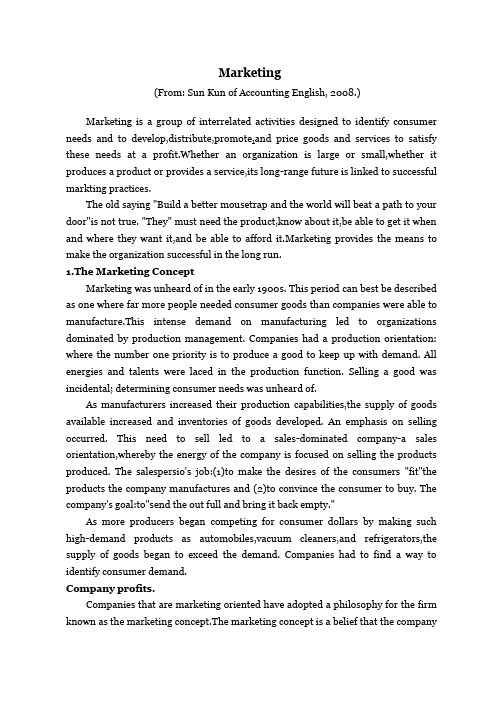
Marketing(From: Sun Kun of Accounting English, 2008.)Marketing is a group of interrelated activities designed to identify consumer needs and to develop,distribute,promote,and price goods and services to satisfy these needs at a profit.Whether an organization is large or small,whether it produces a product or provides a service,its long-range future is linked to successful markting practices.The old saying "Build a better mousetrap and the world will beat a path to your door"is not true. "They" must need the product,know about it,be able to get it when and where they want it,and be able to afford it.Marketing provides the means to make the organization successful in the long run.1.The Marketing ConceptMarketing was unheard of in the early 1900s. This period can best be described as one where far more people needed consumer goods than companies were able to manufacture.This intense demand on manufacturing led to organizations dominated by production management. Companies had a production orientation: where the number one priority is to produce a good to keep up with demand. All energies and talents were laced in the production function. Selling a good was incidental; determining consumer needs was unheard of.As manufacturers increased their production capabilities,the supply of goods available increased and inventories of goods developed. An emphasis on selling occurred. This need to sell led to a sales-dominated company-a sales orientation,whereby the energy of the company is focused on selling the products produced. The salespersio's job:(1)to make the desires of the consumers "fit"the products the company manufactures and (2)to convince the consumer to buy. The company's goal:to"send the out full and bring it back empty."As more producers began competing for consumer dollars by making such high-demand products as automobiles,vacuum cleaners,and refrigerators,the supply of goods began to exceed the demand. Companies had to find a way to identify consumer demand.Company profits.Companies that are marketing oriented have adopted a philosophy for the firm known as the marketing concept.The marketing concept is a belief that the companyshould adopt a companywide consumer orientation directed at long-range profitability.It includes the belied that all efforts of the organization should be directed at identifying and satisfyingProduction OrientationCompanies were essentially production-oriented from the latter part of the nineteenth century to about 1920. Emphasis was placed on filling the demand for basic commodities. The typical family had little discretionary income and there was little demand for products not associated with filling those basic family requirements.Demand was usually supplied by the producer's perception of what consumers needed. Product design and product line decisions were heavily influenced by manufacturing considerations.Management attention was directed primarily toimproving production methods,increasing output,and lowering costs. Sales OrientationThe period of sales orientation covered roughly the years from 1920 to 1950.With the exception of the years of the Grat Depression ,this period was characterized by gradually rising discretionary income,emerging demand for products,increasing competition,and the expansion of distribution channels.Although product decisions continued to be dominated by what the manufacturing department wanted to make ,the role of sales became increasingly important. With the production department capable of tuning out increasing quantities of goods through mass production techniques,company success began to turn on the ability of the sales force to move inventories.Market OrientationCovering the years from about 1950 to 1970 ,this period was characterized by a continuing shift in business emphasis to understanding and reacting to changing markets.The dramatic rise in consumer discretionary income following World War II created demand for new products and services. The mobility provided by mass ownership of automobiles encouraged the development of suburbs, new shopping patterns, and changes in distribution methods. Markets became more segmented and more complex. Product life cycles shortened.With these conditions,production people no longer were in a position to determine accurately what would sell. Selling skills were no longer sufficient to overcome the problems created when products were not attuned to a more discriminant market demand. In order to provide a better fit between marketdemand and company offerings-and in order to provide for better coordination of marketing activities-companies reorganized and assigned increased responsibilities to the marketing department.Marketing took on the role of analyzing markets and interpreting the needs, and manufacturing departments. More sophisticated aproaches were developed to fulfill the traditional marketing roles of product promotion and the management of distribution channels. The role of marketing in pricing increased.And finally, the marketing department became the focal point for the development of corporate strategies needed to adjust to market change.Societal OrientationWhen managements adopted the marketing concept, they could not foresee the environmental problems or the changes in society's values that would raise questions about the market orientation philosophy. In terms of what we now know about pollution, the finiteness of raw materials, and the apparent inability of our economic system to eliminate poverty, some people question whether what is good for the individual consumer is always good for society.Increasingly, national policy-and, in turn, business policy-is tempering concern for the consumer with concern for society as a whole. Thomas A. Murphy, chairman of General Motors, addressed this dilemma when he said , "We may have let ourselves grow out of touch with the customer's need for continued satisfaction in a time of heightened expectations and the society's concern for environmental improve-ment and energy conservation."Marketing policies attuned to serving the market as the market wants to be served continue to represent modern company policy. But we are also seeing market-oriented decisions modified by societal concerns, as a result both of law and of responsible management policies.2.Channels of distributionEfficient production methods, coupled with skilful marketing ,may have ensured that we can produce goods or services cheaply and that there is a market for them. There remains the vitally important question of how we actually get our goods and services to the customer.Direct sales to CustomersThis ,of course, is the oldest form of distribution and in many trades it remains the most important. However, it can be a very awkward one in somebusinesses such as manufacturing. Customers especially private buyers, are unlikely to go to a factory to buy what they want, and manufacturing firms , at least one company seeking to sell its chains of petrol filling stations in the mid 1980s.There are other trades where producers sell directly to customers. In some cases this is because producers find it advantageous to control the final retail stage and be in a position to offer a complete service, including after-sales service,to the customer.In other industries producers may sell directly to consumers through factory shops, farm shops ,"pick-your-own" arrangements at farms,by mail order or any other scheme that business ingenuity may devise.Organized MarketsAfter direct selling ,markets represent the oldest form of trade from producer to consumer. Here we have in mind not the ratail mardets found in many towns on "market days" but the markets where producers and traders, especially the traders in commodities make their deals . These markets , located in many of the world's major trading centers , including London where most of the main British commodity exchanges are found ,bring together producers and traders who wish to buy in bulk for onward Distribution to the final customer.By commodities we mean goods such as tin, copper , zinc and other metals or bulk foodstuffs like tea, coffee, wheat and cocoa. What distinguishes commodities is that they tend to be sold on the basis of objective descriptions , such as " Brazilian coffee" or "Sri Lankan tea", rather than according to some brand name, though, of course, the experienced buyer will be able to distinguish high and low quality goods according to their source or to a wholesaler.WholesalingThe markets we have just outlined are wholesale markets . Wholesaling involves purchasing goods in large quantities from the producer or importer and selling in smaller quantities to the retailer, or sometimes, to another wholesaler or dealer. A service is provided as the producer prefers to deal with large orders and the retailer in smaller purchases. There are ,however, other services provided by wholesaling besides this 'breaking bulk.Conventional wholesaling has declined in importance in recent decades. The functions of wholesaling still have to be undertaken but are now often less important than in the past and where they remain essential are often carried out by manufacturers, or, more noticeably, by retailers. The growth of large chains inretailing has often been made possible by the incorporation of wholesaling and retailing within the one organization.Develoments in production methods, in transport and communications have all contributed to this process . When flour was sold by millers in large sacks, breaking bulk was a necessary service for small shops selling to ordinary households. Modern machines have no difficulty in packing flour in paper bags at the end of the production line. Motorway transport, the telephone and telex have brought retailer and manufacturer closer together and the wholesaler's warehousing is not always essential to bridge the gap between them. AgentsAgents may offer an alternative to wholesalers. An agent acts on behalf of another, the principal. The role of the agent in distribution is to take over the work of distribution from the manufacturer. In some ways agents may act much like a wholesaler; in other ways they may act like a retailer and sell to the final customer. Agents can be particularly important in servicing foreign markets where they have special local knowledge.FranchisingThis is a growing form of distribution. A franchise gives the sole right to serve a locality with a particular good or service. Agents often hold sole franchises.The modern trend in franchising is for producers carefully to develop and market the product, including the organization of advertising,and then to leave the retail stage to a franchised independent firm. The franchise holder normally has to pay for the franchise. In return they receive a wide range of services from the producer. The shop will be laid out according to a distinctive pattern. Special equipment will be provided,training given and exclusive supplies of materials provided.Franchising has been particularly important in some service trades such as fast foods. Its supporters claim that it combines the individual'entrepreneurship' of the independent franchise holder with the economies of large scale production, advertising and so on. It also provides a role for small firms and personal initiative in an economy which often seems to be dominated by large organizations . The system's critics claim that large producers favor it as it gives them retail outlets and retail management at very low cost. It can also lead to frustrated expectations among the franchise holders who will never truly be 'their own bosses.The marketing MixAs with all business decisions, there is no one right form of distribution andno one right approach to marketing a firm's products. Indeed a single firm may choose different ways of marketing different products. Marketing and distribution managers must choose a combination of different strategies in response to an environment in which a number of forces, many of them beyond their control, are at work. The chosen marketing mix (or market mix) of price, distribution channel, advertising and product promotion must be the result of careful analysis of the environment, the available strategies and the nature of the firms product.市场营销市场营销是一组相互关联的活动,用于确定消费者的需求并对商品和服务进行开发、分销、促销和给产品和服务定价,从而在赢利的前提下满足这些需求。
市场营销 英文作文

市场营销英文作文Marketing is all about understanding the needs and wants of customers. It's about creating products and services that people actually want to buy, and then finding ways to let them know about it.In today's digital age, social media plays a huge role in marketing. It's a way for companies to connect withtheir customers on a more personal level, and it allows for instant feedback and interaction.But traditional marketing methods are still important. Things like print ads, TV commercials, and billboards are still effective ways to reach a large audience.One of the most important aspects of marketing is branding. A strong brand can set a company apart from its competitors and create a sense of trust and loyalty among customers.Marketing is also about staying ahead of the curve.It's about keeping up with the latest trends and technologies, and finding new and innovative ways to reach customers.Ultimately, marketing is about creating value for both the customer and the company. It's about finding ways to meet the needs of the customer while also achieving the goals of the business.。
市场营销导论复习笔记 英文原版(中文翻译)
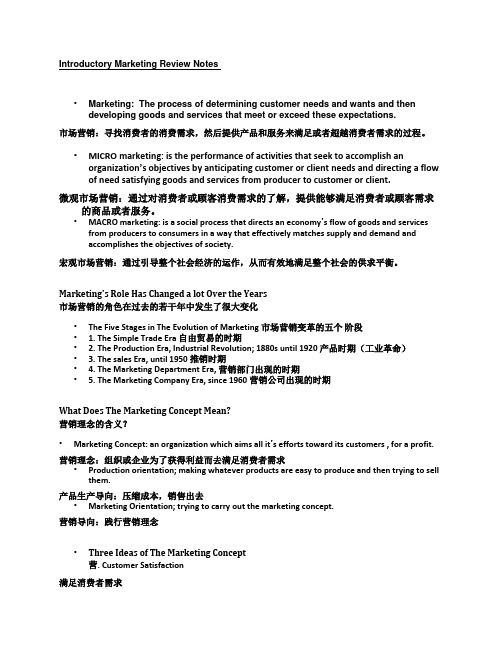
Introductory Marketing Review Notes•Marketing: The process of determining customer needs and wants and then developing goods and services that meet or exceed these expectations.市场营销:寻找消费者的消费需求,然后提供产品和服务来满足或者超越消费者需求的过程。
•MICRO marketing: is the performance of activities that seek to accomplish an organization’s objectives by anticipating customer or client needs and directing a flow of need satisfying goods and services from producer to customer or client.微观市场营销:通过对消费者或顾客消费需求的了解,提供能够满足消费者或顾客需求的商品或者服务。
•MACRO marketing: is a social process that directs an economy’s flow of goods and services from producers to consumers in a way that effectively matches supply and demand andaccomplishes the objectives of society.宏观市场营销:通过引导整个社会经济的运作,从而有效地满足整个社会的供求平衡。
Marketing’s Role Has Changed a lot Over the Years市场营销的角色在过去的若干年中发生了很大变化•The Five Stages in The Evolution of Marketing 市场营销变革的五个阶段• 1. The Simple Trade Era 自由贸易的时期• 2. The Production Era, Industrial Revolution; 1880s until 1920 产品时期(工业革命)• 3. The sales Era, until 1950 推销时期• 4. The Marketing Department Era, 营销部门出现的时期• 5. The Marketing Company Era, since 1960 营销公司出现的时期What Does The Marketing Concept Mean?营销理念的含义?•Marketing Concept: an organization which aims all it’s efforts toward its customers , for a profit.营销理念:组织或企业为了获得利益而去满足消费者需求•Production orientation; making whatever products are easy to produce and then trying to sell them.产品生产导向:压缩成本,销售出去•Marketing Orientation; trying to carry out the marketing concept.营销导向:践行营销理念•Three Ideas of The Marketing Concept营. Customer Satisfaction满足消费者需求• 2. Total Company Effort企业的付出• 3. Profit, not just Sales as the objective.利润,不仅仅在销售方面销理念的三个概念•Micro-macro dilemma; What is good for the firm may not be good for society.宏观市场的窘境:对企业好的并不一定对社会好。
市场营销-英文版
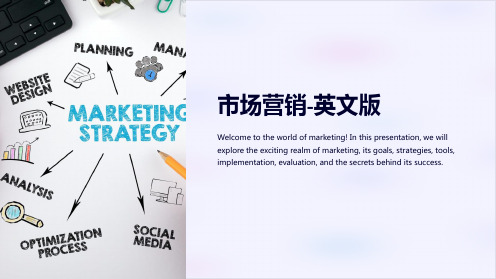
Welcome to the world of marketing! In this presentation, we will explore the exciting realm of marketing, its goals, strategies, tools, implementation, evaluation, and the secrets behind its success.
3 创造独特的价值
4 团队合作
通过差异高效的团队合作和沟通机制,共同追 求市场营销目标,并分享成功和经验。
1
定价策略
2
确定产品或服务的价值,制定合适的
价格策略,以吸引客户、实现盈利并
保持与竞争对手的价格竞争力。
3
市场细分
根据消费者的需求、偏好和行为特征, 将市场划分为不同的细分市场,以便 更好地定位和满足目标客户。
促销和广告
利用各种推广手段和媒体渠道,向潜 在客户传递产品或服务的价值和特点, 以激发购买欲望并建立品牌认知。
市场营销的评估
通过监测和分析销售数据、市场份额、客户满意度、品牌认知和营销活动的 投资回报,评估市场营销的绩效,并进行必要的调整和改进。
市场营销的成功秘诀
1 创新和不断学习
2 客户导向
持续关注市场趋势,推陈出新,不断学习 和适应变化是取得市场营销成功的关键。
深入了解客户需求,提供个性化和有价值 的解决方案,建立和维护良好的客户关系。
市场营销的定义
市场营销是通过市场研究和分析,以及推广和销售产品或服务的一系列活动, 旨在满足客户需求、实现组织的目标,并与竞争对手保持竞争优势。
市场营销的目标
市场营销的目标是以盈利为导向,通过塑造品牌形象、增加销量和市场份额、 改善客户满意度,并实现长期的经济增长和组织的可持续发展。
Introduction to Marketing(市场营销概论 英文版)1.5 production orientation

• Figure1.1 1 identify needs and wants of specifically defined target markets确认目标 市场的需要和想要 2 decide which needs and wants to meet i.e. concentrate on certain segments of the target market决定满足哪些需要和想要 i.e.专注特定目 标市场的细分 3 design products and services of value which meet prospective customer’s needs设计满足潜在顾客需要的产品和服务 4 Test products and services and modify if necessary检测产品和服务,如 果有必要的话做出相应的修改 5 achieve organisational goals through customer satisfaction通过顾客的满 意实现组织的目标 6 continuous feedback连续的反馈
sales orientation销售导向:company sells what it makes,it does not make what it can sell公司卖它生产出的产品,而不生产它能卖 的产品.
1.5.2 The sales concept states that effective demand must be created through persuasion using sales techniques.销售概念表明通过销售技巧的说 服能创造出有效的需求
市场营销管理手册(英文版)

市场营销管理手册(英文版) Chapter 1: Market Analysis and Research1.1. Understand the importance of market analysis1.2. Conduct market research1.3. Analyze market trends and customer behavior1.4. Identify target markets and customer segments1.5. Use SWOT analysis for strategic planningChapter 2: Marketing Strategy2.1. Develop a marketing strategy aligned with business objectives 2.2. Define unique selling propositions2.3. Set marketing goals and objectives2.4. Determine pricing strategies2.5. Create a brand positioning statement2.6. Select marketing channels and distribution strategies Chapter 3: Product Development and Management3.1. Understand the product lifecycle3.2. Conduct market testing and product research3.3. Develop and launch new products3.4. Manage existing product portfolios3.5. Implement product life extension strategies3.6. Monitor and analyze product performanceChapter 4: Marketing Communications4.1. Develop an effective marketing communication plan4.2. Use integrated marketing communications4.3. Select appropriate communication channels4.4. Create compelling advertising campaigns4.5. Utilize public relations and media relations4.6. Manage and measure marketing communication effectiveness Chapter 5: Digital Marketing and Social Media5.1. Understand the significance of digital marketing5.2. Develop a digital marketing strategy5.3. Utilize various digital marketing channels5.4. Optimize websites for search engines5.5. Leverage social media for marketing purposes5.6. Monitor and measure digital marketing performance Chapter 6: Marketing Analytics and Performance Measurement 6.1. Understand marketing analytics and metrics6.2. Measure and analyze marketing effectiveness6.3. Monitor and evaluate return on investment (ROI)6.4. Utilize customer relationship management (CRM) tools6.5. Implement data-driven decision making6.6. Continuously improve marketing strategies and activities Chapter 7: Marketing Team and Leadership7.1. Build an effective marketing team7.2. Define roles and responsibilities7.3. Provide effective leadership and motivation7.4. Foster a culture of innovation and creativity7.5. Develop talent through training and development7.6. Encourage teamwork and collaborationChapter 8: Ethical and Legal Considerations in Marketing8.1. Understand ethical issues in marketing8.2. Comply with legal requirements and regulations8.3. Adhere to industry standards and codes of conduct8.4. Maintain consumer privacy and data protection8.5. Engage in fair and honest advertising practices8.6. Handle customer complaints and conflicts ethicallyConclusion:The Marketing Management Manual serves as a comprehensive guide for marketers to develop successful marketing strategies, execute effective campaigns, and achieve organizational objectives. By utilizing the principles, tools, and best practices discussed in this manual, marketing professionals can stay ahead in the dynamic and competitive marketplace. The manual encourages continuous improvement, innovation, and ethical practices, ensuring long-term success and customer satisfaction.Chapter 1: Market Analysis and Research1.1 Understand the importance of market analysisMarket analysis is a crucial step in developing a successful marketing strategy. It involves gathering and analyzing data about the target market, competition, and industry trends. By conducting comprehensive market analysis, marketing managers can identify opportunities, understand customer needs and preferences, and make informed decisions. It helps in identifying the right target market, positioning the product or service effectively, and setting realistic goals and objectives.1.2 Conduct market researchMarket research is the process of collecting and analyzing data about the market, customers, and competitors. It provides valuable insights into consumer behavior, market trends, and industry dynamics. Market research can be conducted using various methods such as surveys, focus groups, interviews, and observation. The data collected through market research helps marketers in understanding customer needs, identifying market segments, and making informed business decisions.1.3 Analyze market trends and customer behaviorAnalyzing market trends and customer behavior is essential for understanding the dynamics of the market. By monitoring market trends, marketers can identify emerging opportunities and threats, and adapt their marketing strategies accordingly. Understanding customer behavior helps in designing effective marketing campaigns, developing products or services that meet customer needs, and providing an enhanced customer experience. Marketers can use various data analysis techniques and tools to gain insights into customer behavior and market trends.1.4 Identify target markets and customer segmentsIdentifying target markets and customer segments is critical for effective marketing. Target markets are specific groups of customers that a company wants to focus its marketing efforts on. By identifying the target market, marketers can tailor their marketing strategies and activities to meet the needs and preferences of that particular segment. Customer segmentation involves dividing the market into smaller groups based on similar characteristics such as demographics, psychographics, and behavior. This allows marketers to create customized marketing messages and offers that appeal to each segment.1.5 Use SWOT analysis for strategic planningSWOT analysis is a framework used to assess the internal strengths and weaknesses of a company and the external opportunities and threats it faces. By conducting SWOT analysis, marketers can identify the company's competitive advantages, uncover areas for improvement, and evaluate market opportunities and threats. This analysis helps in developing effective marketing strategies by aligning the company's strengths with market opportunities and addressing its weaknesses and threats. It also helps in identifying potential risks and challenges that may impact the success of marketing campaigns.Chapter 2: Marketing Strategy2.1 Develop a marketing strategy aligned with business objectivesA marketing strategy is a plan of action designed to achieve the marketing objectives of a business. It provides a roadmap for how the company will reach its target market, differentiate itself from competitors, and achieve its business goals. A successful marketing strategy is aligned with the overall business objectives and considers factors such as target market, competitive landscape, and available resources. It outlines the marketing mix (product, price, place, promotion) and the tactics needed to implement the strategy effectively.2.2 Define unique selling propositionsA unique selling proposition (USP) is a distinctive feature or benefit that sets a product or service apart from competitors. It answers the question, "Why should customers choose our product or service over others?" Defining a USP is crucial for positioning the brand effectively in the market and attracting the target market. It involves identifying the unique features, benefits, or attributes that make the product or service desirable to customers. The USP should be communicated clearly and consistently in all marketing communications to differentiate the brand and create a competitive advantage.2.3 Set marketing goals and objectivesSetting marketing goals and objectives provides direction and focus for marketing efforts. Goals are broad statements of what the company wants to achieve, while objectives are specific, measurable, achievable, relevant, and time-bound (SMART). Goals and objectives should be aligned with the overall business objectives and the desired outcomes of themarketing strategy. They can include increasing market share, generating leads, improving brand awareness, boosting sales, or enhancing customer satisfaction. Setting clear goals and objectives allows marketers to track progress, make adjustments when necessary, and evaluate the success of marketing efforts.2.4 Determine pricing strategiesPricing strategies play a crucial role in determining the perceived value of a product or service and influencing customer buying decisions. Marketers need to consider various factors such as production costs, competitor pricing, customer perception of value, and overall marketing objectives when determining pricing strategies. Pricing strategies can include cost-based pricing, where the price is based on production costs and desired profit margins, or value-based pricing, where the price is based on the perceived value of the product or service in the market. Promotional pricing, bundle pricing, and penetration pricing are other common pricing strategies used by marketers.2.5 Create a brand positioning statementA brand positioning statement defines how a brand wants to be perceived in the minds of the target customers. It communicates the brand's unique value proposition and differentiates it from competitors. A brand positioning statement typically includes the target market, the brand's unique attributes, and the benefits it provides to customers. It should be clear, concise, and memorable. A well-crafted brand positioning statement guides all marketing communications and activities, ensuring consistency and effectiveness in reaching the target market.2.6 Select marketing channels and distribution strategiesMarketing channels and distribution strategies determine how a product or service reaches the target market. Marketers need to carefully select the most appropriate channels based on factors such as customer preferences, geographic reach, cost-effectiveness, and competitive advantages. The choice of distribution strategies, such as direct sales, wholesalers, retailers, or e-commerce, depends on various factors such as the nature of the product, target market, and supply chain capabilities. Effective channel selection and distribution strategies ensure that the product or service is available to customers when and where they want it, leading to increased sales and customer satisfaction. (Continued in the next chapter...)。
- 1、下载文档前请自行甄别文档内容的完整性,平台不提供额外的编辑、内容补充、找答案等附加服务。
- 2、"仅部分预览"的文档,不可在线预览部分如存在完整性等问题,可反馈申请退款(可完整预览的文档不适用该条件!)。
- 3、如文档侵犯您的权益,请联系客服反馈,我们会尽快为您处理(人工客服工作时间:9:00-18:30)。
Chapter one International marketing briefing 1.1 What is marketing 1.2 what is iternational marketing 1.3 international marketing of Chinese companies 1.4 marketing management orientations
2013/7/24 14
According to Maslow's hierarchy of needs, he divides human's needs into five levels: basic needs, safety needs, social needs, esteem needs and self-fulfillment needs. He usually uses a triangle or pyramid shape to describe his theory. ● Question: do the marketers create human needs?
●
needs, wants and demands product consumer value and consumer satisfaction exchange, transaction and relationships markets
2013/7/24
13
1 needs, wants and demands
18
2013/7/24
●
Demands: human wants that are backed by buying power.
When backed by buying power, wants beco/24
19
2 product
Marketing offer: some combination of products, services, information, or experiences offered to a market to satisfy a need or want. ● Many sellers make the mistake of paying more attention to the specific products they offer than to the benefits and experiences produced by these products. These sellers suffer from “marketing myopia”.
●
2013/7/24
8
●
Objectives (学习目标) ------Page 3
terms ------page 14
●Key
●Notes
------page 14-15
2013/7/24 9
1.1 What is marketing
1.1.1 The definition of marketing ① Page 3 ②Marketing: a social and managerial process by which individuals and groups obtain what they need and want through creating and exchanging value with others.
2013/7/24 16
●
●
●
Basic needs are relatively few, but people's wants are unlimited, they are shaped by social influences, their past history and consumption experiences. Different people, then, may have very different wants to satisfy the same need. Everyone needs to keep warm on cold winter nights, for instance. But some people want electric blankets, while others prefer oldfashion down comforters. Just because of this, it give room or scope to the marketer.
2013/7/24 2
Main Content
Part Ⅰ: International Marketing Basics Prat Ⅱ: The International Marketing Environment Part Ⅲ: Targeting International Markets Part Ⅳ: International Marketing Mix(4Ps) Part Ⅴ: Managing the International Marketing PartⅥ: E-commerce and Online Marketing
● ●
●
Need: states of felt deprivation. The most basic concept underlying marketing is that of human needs. Needs are the basic forces that drive customers to take action and engage in exchanges. We all have basic physical needs critical to our survival, such as food, drink, warmth, shelter, sleep and security. We also have social and individual needs critical to our psychological well-being, social need for belonging, love, esteem and individual needs for knowledge and self-fulfillment.
●
2013/7/24 22
4 exchange, transaction and relationships
Exchange: the act of obtaining a desired object from someone by offering something in return. ● Exchange is the core of marketing.
●
2013/7/24 15
●
Wants: the form human needs take as shaped by culture and individual personality.
A person wants particular products, brands and services to satisfy a need. A person is thirsty and wants a Coke. A person is tired and wants a vacation in Shanghai.
International Marketing
Huili Shang Associate Professor
Doctor
2013/7/24 1
Lectures design
1、2*15=30 2、Reference book: Marketing : An introduction Gary Armstrong(加里· 阿姆斯特朗) Philip Kotler(菲利普· 科特勒) 3、Communication: if you have any question, don not hesitate to let me know.
●
2013/7/24
23
These conditions must be met before an exchange occurs:-----five conditions
2013/7/24
3
人口经 济环境
营销 中介
技术自 然环境
产品
供应 商 分 销
目标 顾客
促销
价 格
公众
基 本 内 容
政治法 律环境
2013/7/24
竞争者
社会文 化环境
4
要注意区别的几个问题
角度问题
营销人员与销售人员
要注意的问题
宏观营销与微观营销
2013/7/24
5
营销人员与销售人员的区别
营销人员 销售人员
(1)Customer needs and wants (2)R&D (3)Engineering (4)Manufacturing (5)Customer value
2013/7/24
12
1.1.3 basic elements of the marketing concept---P 4
1 ● 2 ● 3 ● 4 ● 5
2013/7/24 17
●
A major part of a marketer's job is to develop a new product or service and then to stimulate customer wants for it by persuading people it can help them better satisfy one or more of their needs. For example, homeowners might buy a home security system to satisfy their need for personal safety.
